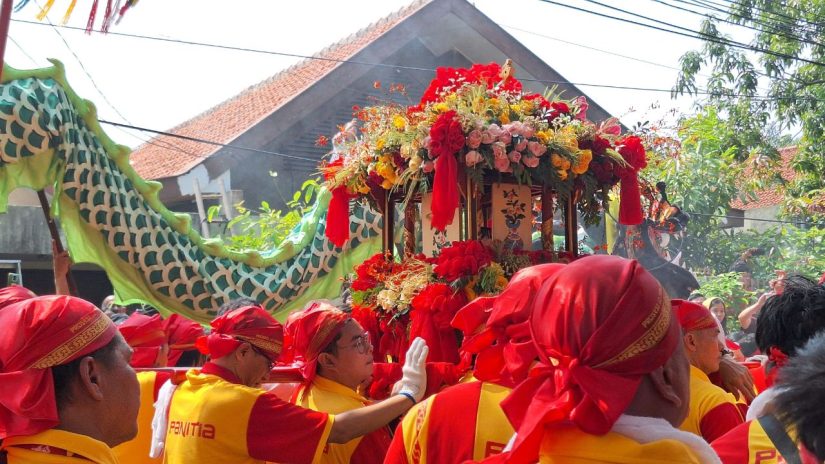
Refan Aditya, The Modern Endangered Archives Program (MEAP)
On September 21, 2024, Tangerang’s Chinatown Pasar Lama was abuzz with the cheers of thousands of people. They came to witness the most anticipated procession of the Benteng Chinese Peranakan: Gotong Toapekong 12 tahunan (12-yearly of Gotong Toapekong). Since it is only performed once every 12 years in the Dragon year of the lunar calendar, thousands of tourists flock from all over to visit this Chinatown district.
Gotong Toapekong is one of the most grandiose Chinese folk religion rituals that engages the wider public, not only the Chinese but also the non-Chinese communities around, making this ritual performace as a part of the mass culture that is both sacred and festive. Gotong Toapekong presents a parade of kimsin or deity statues that are taken out of the klenteng and carried around the city or Chinatown, serenaded with various art performances, such as drumming music, tatung, or spirit medium, and cengge or cosplay (costume play) of Chinese legendary figures such as Sun Go Kong and the Goddess of Kwan Im. Hence, Gotong Toapekong features the street as an important place where Chinese folk religion is performed and preserved, alongside the klenteng, Chinese cemetery, and home.
The ritual’s narrative of ‘held once every 12 years’ has a particular appeal. According to a popular account, in 1844, the Boen Tek Bio Klenteng, where the deities resided, was undergoing major renovations. During the renovation phase, the deity that is manifested in the form of statues was taken to another klenteng. After the renovation was completed, the deity statue was brought home in a parade. 12 years later, in 1856, the local community organised the first Gotong Toapekong to commemorate this historical, sacred moment. The Year of the Dragon returns in 2024, and this year is the 15th celebration of this folk festival.
This Gotong Toapekong features a procession of statues of the three deities of the temple, namely Goddess Kwan Im, God Kwan Kong, and God Kam La Ya, around the Pasar Lama area of Tangerang, from the neighbourhood of Boen Tek Bio to Al-Ittihad Grand Mosque, to the riverside of Cisadane, and back to the klenteng. Though the sun was blazing hot, the streets of this route were full of delight and festivities.
Once Faded and Revived after Reformation
The jubilant cheers, Liong dances, and drumbeats of this celebration were once drowned out during the New Order regime. The politics of assimilation exerted by the Soeharto government suppressed cultural and religious expressions that were deemed not of Indonesian origin, especially Chinese. Hence, the tradition of Gotong Toapekong, although it had existed long before the Indonesian state existed, was considered to not be an Indonesian tradition. The New Order period, from 1965 to 1998, was a dark period for Chinese citizens and culture. Everything Chinese was not counted as ‘authentic’ Indonesian, including the expression of their traditions.
It was only after the end of the New Order and the withdrawal of anti-Chinese discriminatory policies by President Abdurrahman Wahid that the Chinese regained their rights and freedom to perform their traditions in public spaces. The WBTB (Warisan Budaya Tak Benda, National Intangible Cultural Heritage) recognition granted for this 12-yearly Gotong Toapekong last August solidified this Chinese festival and ritual as part of the repertoire of Indonesian cultural traditions and expressions. The institutionalisation of Chinese celebrations into national cultural heritage illustrates a political manoeuvre of the Chinese or Ciben (Cina Benteng) community in realising what Kristian Stokke (2017) termed substantive citizenship, which involves membership, legality, rights, and full participation in citizenship.
Chinese are no longer seen as non-Indonesians. The recently popular term Chindo seems to refresh the ethnic identity that stands alongside Javanese, Minang, and Malay. And this magnificent festival on the public streets is a token that the celebration of Chinese culture is also a celebration of Indonesian folk culture. Nevertheless, the paradigm of religious governance in Indonesia dictates that only the official religions can be performed as ‘the religious’ in the public sphere, making the cultural negotiation necessary for religious traditions that fall outside the domain of official religion, such as Gotong Toapekong, to not only be acknowledged as an Indonesian folk culture but also to be celebrated as the sacred one even though it is expressed as cultural and is perceived as non-religious and touristic by the state paradigm.
Religious, Religion, Religions
Despite its recognition as the folk celebration of Tangerang people, there is another discourse that appears to be less popular surrounding the 12-yearly Gotong Toapkeong, namely, whether it is celebrated as a religious or cultural event. Here, it is worth opening up the discourse on religious, religion, and religions. To put simply, religious is an adjective to designate a phenomenon associated with religion, whereas religion is an analytical, fabricated category, and religions (plural) are what belong to the category of religion, such as Islam, Catholicism, Christianity, Hinduism, Buddhism, and Confucianism.
Jonathan Z. Smith is among the scholars who have dismantled this common assumption. Through his essay Religion, Religions, Religious (1998), he reveals the hegemony and the agenda of 16th-century European colonialism within the categorisation of religion. The concept of religion came from the colonisers to enforce the mission of Christianity on the colonies by applying the doctrine of the universality of Christianity to legitimise which forms of practices were allowed to exist as religious and which were forbidden as superstition. This civilising paradigm, even though it has been deconstructed and abandoned in the course of time, is still influential, especially in the former colonies’ state in dealing with the religious lives of their people. Indonesia is no exception. The framing of Gotong Toapekong as ‘cultural heritage’ is an illustration of how the colonial paradigm influences the way state authorities understand Chinese religious traditions. Gotong Toapekong is portrayed as a tourism event that emphasises its commodification of cultural heritage rather than religious expression since the religious domain in Indonesia has been so monopolised by official religious authorities. Indeed, the cultural turn in perceiving this tradition is liberating yet marginalising at the same time.
The landscape of politics of religion in Indonesia, which monopolises the meaning of religion and religious affairs, precludes Chinese religious traditions from appearing as ‘religious’ celebrations. The secularisation wave that separates public affairs from religious affairs in the North has influenced the global South to conform its religious governance for the sake of ratifying ‘universal’ human rights principles and freedom of religion and belief. The rationale is that religious matters are the domain of private affairs that cannot be mixed with public affairs. When some occasion is religious but public, the most appropriate frame for it is the cultural frame. Here, Talal Asad (2003) uses the term ‘the secular’ to explain the symptoms of modernity that are entirely orientated to rational and material worldviews in European societies that departed from the mythic phase of lives. Understandably, ‘the cultural’ is then a mere projection of the secular.
In Indonesia, the governance of religion is a different case. If in secular countries religion is kept to the domestic or personal sphere, in Indonesia, there is a privileged space for religion in the public sphere. Michle Picard (2011) describes how the politics of religion in Indonesia is characterised by ideas of religious majoritarianism and the first principle of Pancasila, whereby the definition of religion is under the authority of the state. Accordingly, the religion of the majority has become the standard for determining what can be called a religion and allowed to be performed as religious.
In turn, the ‘cultural’ framing of the Chinese religious procession minimises its sacred dimension and maximises the profane, touristic dimension, which is orientated towards the government’s economic interests. Indeed, the status of cultural heritage has been a step forward in recognising Chinese citizenship and traditions in Indonesia; however, a cultural turn in understanding these Chinese traditions is likely silencing its religious dimension. The 12-year Toapekong Gotong in Tangerang illustrates the complexity of Chinese religious tradition and citizenship in Indonesia. In such a cultural commodification setting, along with the majoritarianism landscape of politics of religion in Indonesia, is it possible to take a religious turn to portray Chinese traditions?
Religious Experiences in Gotong Toapekong
A teenage Chinese girl was thrilled to have a wad of red cloth thrown at her from the main room of the Boen Tek Bio Klenteng. In that excited mood, I asked her, ‘What will you use this for at home?’ With joy and innocence, she replied, “I don’t know; I’m just following the others.” I also asked the same question to the elderly lady who caught a similar item. She said, “This is to be kept in the business cupboard for successful business and good luck.” A teenage boy among them, in the same atmosphere in the temple courtyard, gave another answer. They said, ‘This will be displayed on the door of the house for the blessing of the house.’ Those who had not yet received anything eagerly stretched their hands upwards, preparing to grab anything that was thrown out of the palanquin of the deity towards the crowd. In that very atmosphere, suddenly, a wad of red cloth was thrown right at me. For no obvious reason, I was immediately immersed with the same feeling of excitement.
Since it is held once every 12 years, for Chinese teenagers, participating in this Gotong Toapekong festival is their first time. For the middle-aged, it may be their second or third time. For them, parading their lord deities through the city is a religious experience that transcends any conventional sense of religion. In this festive moment, what is religious is no longer measured by established terms but rather spans from the intimate experience of one’s own relationship with the spirit of the deity to the shared jubilation amidst the blazing heat and noise. This is what Adam Yuet Chau (2006) describes as ‘the most desirable mode of sociality’ in Chinese tradition. Festivity is also the manifestation of the religious. Therefore, ‘the religious’ in the Gotong Toapekong procession, however it may be experienced, transcends the individual’s inner solitude and joins a shared celebration, as this Chinese religious tradition historically has long been part of the religious expression of Chinese identity in Indonesia, long before the idea of religion emerged or WBTB status was promulgated.
Instead of normative dogmatism, a performative turn, to borrow Peter Burke’s (2015) term, is required to deliberately understand the Chinese religious tradition. By performative approach, ‘the religious disclosure’ transcends all forms of definitive standards of what religion is, regardless of whether it is framed as religion or culture, as long as its sacredness remains resonant, albeit under a touristic gaze. The religiosity of Gotong Toapekong is manifested in an expressive and festive performance, no matter whether this celebration is regarded as religious or cultural. The religious experience of participants I encounter in this procession, however, begs us to re-examine what religion is for ordinary people.


